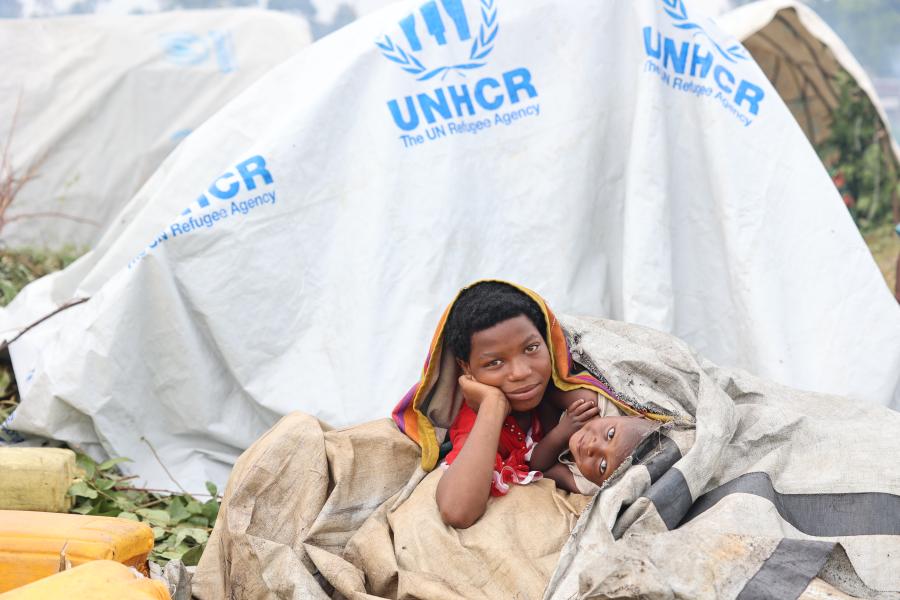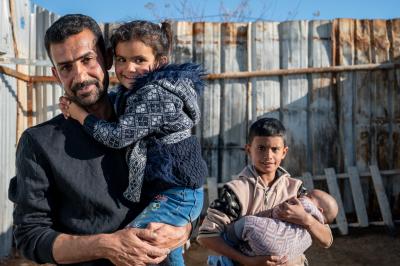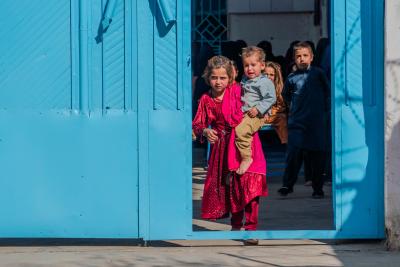Expenditure by Impact Area
Under Impact Area 1, expenditure of $1.530 billion accounted for 29.6% of UNHCR’s total expenditure. This was an increase of $313.6 million or 25.8% when compared to $1.216 billion in 2022. UNHCR continued to advocate for the rights of forcibly displaced and stateless people and for a strengthened protection response. For example, UNHCR strengthened its registration and documentation capacity, with 28.2 million people individually registered in the Population Registration and Identity Management EcoSystem (PRIMES).
Under Impact Area 2, expenditure of $2.529 billion accounted for 49.0% of the total, a decrease of $555.5 million or 18% when compared to $3.084 billion in 2022. With armed conflict and insecurity continuing to drive new displacement and hindering solutions for those in protracted displacement situations, UNHCR stepped up its response in 43 new emergencies in 29 countries, providing life-saving assistance and supporting governments.
Under Impact Area 3, expenditure of $588.5 million accounted for 11.4% of total expenditure. This represents a decrease of $210.3 million or 26.3% when compared to $798.8 million in 2022. UNHCR advocated the integration of refugees into national frameworks and championed refugees’ access to vital services such as health care, education, and employment opportunities.
Under Impact Area 4, expenditure of $511.7 million accounted for 9.9% of total expenditure, an increase of $11.8 million or 2.4% when compared to $499.8 million in 2022. UNHCR worked towards durable solutions, including for example on an engagement strategy with development actors so as to partner more effectively with international financial institutions and others.
Expenditure by region
In West and Central Africa, 2023 expenditure was $482.2 million, an increase of $49.9 million or 11.5% when compared to 2022. This budget increase primarily stems from the crisis in Sudan, the scale of which called for additional resources across the region and particularly in Chad and Niger. In addition to the situation in Sudan, the region continued to grapple with protracted crises such as drought and conflict in the Sahel, the Lake Chad Basin, and in the Central African Republic.
In the East and Horn of Africa and the Great Lakes, expenditure was $875.3 million, a decrease of $72.1 million or 7.6% when compared to 2022. Across the region, the situation remained challenging, with an increased number of IDPs due to conflict in Sudan, long devastating droughts, and growing numbers of refugees.
Expenditure in Southern Africa amounted to $178.2 million, a decrease of 16.7% or $35.7 million compared to expenditure of $213.9 million in 2022. The complex crises in the Democratic Republic of the Congo and Mozambique were the main drivers of forced displacement in the region. At the same time, protracted refugee situations persisted in other countries in the region.
Expenditure in the Middle East and North Africa amounted to $974.2 million, a decrease of $179.4 million or 15.6 % when compared to $1.154 billion in 2022. The region was confronted with multiple emergencies such as the earthquake in the Syrian Arab Republic, massive flooding in Libya, displacement in Egypt from the conflict in Sudan, and displacement in Mauritania due to increased insecurity in Mali.
In Asia and the Pacific, expenditure amounted to $575.1 million, a decrease of $127 million or 18.1% compared to expenditure of $702.1 million in 2022. Climate change complicated displacement across the region, with UNHCR helping build the climate resilience of displaced people by, for example, advocating their inclusion in national disaster risk reduction plans.
Expenditure for Europe amounted to $1.047 billion, a decrease of $60.1 million or 5.4% compared to expenditure of $1.107 billion in 2022. The Ukraine situation remained the largest emergency in the region. Access to decent work, affordable housing and social protection remained key concerns for forcibly displaced in Europe. UNHCR helped address social protection barriers through advocacy, outreach, information, enrolment assistance and legal advice, particularly for the most vulnerable groups.
Expenditure in the Americas amounted to $355.1 million, a decrease of $8.6 million or 2.4% compared to $363.7 million in 2022. There was a notable increase in the number of people on the move in Central and North America. To address these challenges of displacement and mixed movements, UNHCR employed a comprehensive route-based approach to strengthen protection and solutions from countries of origin through transit to final destination.
Country Operational Technical Support (COTS) was introduced in the 2024 programme budget as a separate line under country and regional programmes. COTS relates to activities managed at Headquarters and directly benefiting country operations. If the same was applied for 2023, expenditure under COTS would amount to approximately $118 million.
Global programmes
The expenditure was $426 million, a decrease of $15.1 million or 3.4% compared to $441.1 million in 2022, mainly due to significant investments in the global supply management platforms in support of the Ukraine situation that were completed in 2022. In 2023, significant investments included the 2023 Global Refugee Forum, which aimed at mobilizing new pledges and initiatives.
Headquarters
The expenditure increased slightly by $7.7 million to $246 million or 3.2% compared to $238.3 million in 2022 due to investments in systems development and maintenance across HQ divisions.

Operational reserve
A total of $31.9 million was transferred from the operational reserve: $17.5 million in support of emergency preparedness and response for the situation in Burkina Faso and $14.4 million for the response to the Afghanistan earthquake.
For the situation in Burkina Faso, additional resources were required to address the influx of displaced people from Burkina Faso and neighbouring countries, namely Cote d’Ivoire, Ghana and the Senegal representation office. In Afghanistan, additional resources were required to meet the critical needs of 25% of people in need (56,000 refugee and IDP returnees) in Herat Province, helping cover shelter, WASH, cash assistance and protection activities.
Expenditure via partners
Of UNHCR’s total expenditure, $1.371 billion was implemented through 1,266 funded partners working in 108 operations. Funded partners included 845 national NGOs and 231 government partners. Local and national responders made up 85% of all funded partners, following similar trends as in past years. UNHCR disbursed approximately $778.7 million to local and national responders, which represented 57% of UNHCR´s total partnership funding and 24.4% of overall programme expenditure. Similar to the previous year, UNHCR directly implemented large-scale cash and in-kind assistance programmes in some countries in the Ukraine situation, primarily in Ukraine and the Republic of Moldova, which resulted in a lower share of partnership funding overall. However, in comparison to the first year of the emergency in 2022, there was a higher proportion of local and national partners supporting the response. Discounting the Ukraine situation, 26% of UNHCR´s overall programme budget was spent via local and national responders.
UNHCR continued to invest significantly in localization, including by scaling up its grant agreement mechanism that provides a simple and efficient tool for organizations led by forcibly displaced and stateless people to receive funding directly from UNHCR. A survey carried out with 46 organizations which benefited from these grants previously reported high levels of satisfaction and underscored the grants were useful to ensure community-based engagement and start building the internal capacity of these organizations. This positive feedback enabled UNHCR to raise the budget ceiling for the grants to $12,000 per agreement in late 2023. 107 grant agreements with 93 organizations were signed in 26 countries in 2023, bringing the total of grant agreements to nearly 200 since their launch in 2021.
Read more about our Strategic Partnerships
This table displays how UNHCR used its various sources of income to cover its $5.167 billion expenditure. Unearmarked income was allocated throughout the year in line with identified priorities and needs, and according to the overall objectives of kickstarting emergency operations; bolstering underfunded operations; and enabling programmes to be implemented fully. No unearmarked funding was used for Headquarters.
Voluntary contributions represented the largest source of funding. Earmarked voluntary contributions funded 51% of UNHCR operations, softly earmarked funded 17%, and unearmarked voluntary contributions funded 14%. The largest expenditures funded from earmarked voluntary contributions were in the Middle East and North Africa (23.2%), followed by the East and Horn of Africa and the Great Lakes (20.7%), and Europe (18%).
UNHCR funded $225.4 million or 4% of expenditure from indirect support costs, $184.5 million at Headquarters, $0.9 million under global programmes and $40.1 million in the regions.
Coordination in refugee situations
UNHCR’s planning and budgeting starts at the field level. Planning identifies the needs of forcibly displaced and stateless people. These needs form the basis for operations to produce budgets for the planning year. These budgets are aggregated at global level and then carefully reviewed and approved by ExCom as UNHCR’s global needs-driven budget. This programme budget becomes the basis for the annual Global Appeal. This is the budget for which UNHCR fundraises, and to which donors provide voluntary contributions. Those contributions, together with detailed reporting on what UNHCR was able to do with donors’ support, are reflected in the annual Global Report.
During the year, should operations be faced with emergencies bringing new or unforeseen needs during the planning phase of a significant nature, which cannot be covered within the approved budget, UNHCR may endorse a supplementary budget. The new financial needs come in addition to the operation’s initially approved budget. This supplementary budget is issued externally as an advocacy, communications and fundraising tool in the form of a supplementary appeal.
In some cases, a UNHCR operation’s financial needs and activities are included in whole or in part in various inter-agency coordination response mechanisms plans. Most particularly, these include RRPs – regional or country refugee response plans – and HRPs – humanitarian response plans. The former are coordinated and led by UNHCR for refugee emergency situations (from the onset of an emergency to more protracted situations) and are expressions to operationalize UNHCR’s responsibilities under its refugee coordination mandate and in line with the Refugee Coordination Model (RCM). The latter is coordinated by OCHA for humanitarian response within countries, mainly for people in need of humanitarian assistance (including IDPs) emergencies.
Where relevant, an HRP may also include a separate but integrated inter-agency refugee chapter that outlines the specifics of any refugee response within the country.
Activities included in RRPs or HRPs are not additional to those included in UNHCR’s budget, nor are they duplicative. They are simply expressed within a different framework to the operational plan to show complementarity among all inter-agency partners working in a country or regional response framework. By definition, and because of the nature of refugee movements which are cross-border, a Regional RRP will include several countries within it, whereas a country RRP and an HRP are specific to the country within which it is based. An RRP provides donors with a transparent and coherent picture of the needs of refugees, host communities and other needs, and represents a vetted single strategic response plan coordinated with host governments. To track progress, improve transparency and flag funding gaps, the Refugee Funding Tracker compiles all financial data related to refugee programmes and regional response plans. A similar environment exists for HRPs, with financial tracking provided by OCHA’s Financial Tracking Service.
For RRPs and HRPs, donors do not fund the response plans directly: instead, they fund agencies in the plans for particular activities. Hence the importance of RRPs and HRPs as coordination, and advocacy and fundraising instruments. Those agencies, in turn, are responsible for reporting their funding to UNHCR for inclusion in the Refugee Funding Tracker, or to OCHA for inclusion in the Financial Tracking Service. The more agencies report, and the better the quality of their reporting, the better the information in both tracking systems, with benefits such as better analysis of funding flows. Donors can be and are important advocates for reporting: a donor can itself report its funding, and can also encourage the recipients of their funding to report as well.
Explore other funding sections



